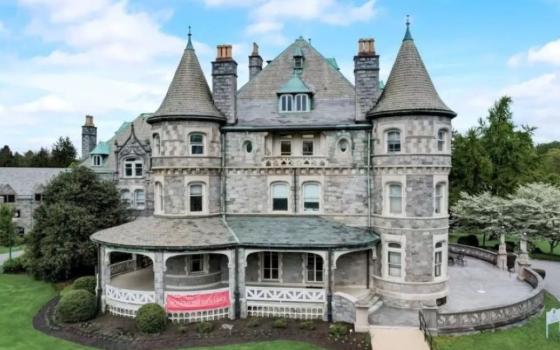 The Catholic church’s attempt to exhume and quietly move the body of Cardinal John Henry Newman has run into controversy, with some saying Newman’s dying wishes are being ignored.
The Catholic church’s attempt to exhume and quietly move the body of Cardinal John Henry Newman has run into controversy, with some saying Newman’s dying wishes are being ignored.
Church officials plan to move Newman’s remains from a grave in a small cemetery in the English town of Rednal to the Oratory church in the city of Birmingham where it will be transferred to a marble sarcophagus and can be venerated by pilgrims.
Newman wrote in his will that he wanted to be buried in the same grave as his longtime friend and spiritual companion, Fr. Ambrose St. John, whom Newman describes as the one great love of his life.
Newman was an Anglican priest who led the Oxford movement in the 1830s to draw Anglicans to their Catholic roots. He converted to Catholicism at the age of 44 after a succession of clashes with Anglican bishops made him a virtual outcast from the Church of England. He died in 1890.
Church officials say the Vatican Congregation for Saints’ Causes wants Newman’s body to be moved into a setting that befits his status as a potential saint. His beatification is expected to be announced later this year.
But British gay rights activist Peter Tatchell has described the removal “an act of religious desecration and moral vandalism.”
In an interview with Ecumenical News International, Tatchell said, “Newman repeatedly made it clear that he wanted to be buried next to his life-long partner, Ambrose St John. No one gave the pope permission to defy Newman’s wishes.
“The re-burial has only one aim in mind: to cover up Newman’s homosexuality and to disavow his love for another man. It is an act of shameless dishonesty and personal betrayal by the gay-hating Catholic Church,” Tatchell said.
 Whether Newman and St. John’s relationship was an actively sexual one has never been clear, but it was indisputably intimate.
Whether Newman and St. John’s relationship was an actively sexual one has never been clear, but it was indisputably intimate.
After St John’s death in 1875, Newman wrote: “I have ever thought no bereavement was equal to that of a husband’s or wife’s, but I feel it difficult to believe that any can be greater, or anyone’s sorrow greater than mine.”
St. John was also an Anglican priest who converted to Catholicism and joined Newman at the Oratory in Birmingham. (The Oratory of Saint Philip Neri is a congregation of Catholic priests and lay-brothers who live together in a community bound together by no formal vows but only with the bond of charity. Newman founded the Oratory in Birmingham in 1848.)
Their burial in the same grave was Newman’s emphatic wish, expressed in a note he wrote July 23, 1876, to Fr. William Neville, his literary executor. The note reads: “I wish, with all my heart, to be buried in Fr. Ambrose St. John’s grave – and I give this my last, my imperative will.”
It is the same note in which he dictates what would become his motto: Ex umbris et imaginibus in veritatem (from shadows and images into truth).
The depth of Newman’s and St. John’s relationship is detailed in scholarly work on “loving coupledom,” titled The Friend by Allen Bray (University of Chicago Press, 2003). The Friend was named book of the year in 2004 by History Today, and received an Award for Excellence from the American Academy of Religion.
One chapter of The Friend focuses on Newman and St. John. In it, Bray, a gay rights activist and respected British historian, explores the published works as well as memoirs, sermon notes and journals of Newman and his contemporaries. With this he reveals the intensity of Newman’s feelings for St. John.
Newman was overwhelmed with grief at St. John’s death. He wrote: “This is the greatest affliction I have had in my life” and later: “a day does not pass without my having violent bursts of crying and they weaken me, I dread them.”
Newman dedicated his Apologia to St. John:
Bray concludes of Newman and St. John: “Their bond was spiritual. … Their love was not the less intense for being spiritual. Perhaps it was the more so.”
Burial with St. John was not Newman’s only wish, according to Bray. He found in one of Newman’s manuscripts a sketch of a grave site that shows “a-s-j” buried below him and “e” and “jospeh” on either side. At the actual site in Rednal, Newman’s casket rests on St. John’s and between Edward Caswall and Joseph Gordon, two men who joined Newman’s Oratory in its earliest days. All preceded him in death.
Bray then tells this story:
“Newman’s room in the Oratory at Brimingham [is] exactly as Newman left it when he died in 1890. At the far side of the room is the altar where Newman (as a cardinal) said Mass, with the pictures of friends that he would remember at his Mass on the wall beside the altar. There one can see the pictures of Joseph Gordon, Ambrose St. John and Edward Caswall. These were as he put it, ‘The three who from the first threw in their lot with me, from the moment they could do so.’ “
Church Times, a London-based Anglican newspaper, is conducting an online poll, asking the question: “Should Cardinal Newman’s remains be moved?” As this story was being posted the Church Times‘ poll was running 22 percent in favor of moving the body and 78 percent against.
You can vote in the poll here: http://www.churchtimes.co.uk/question.asp?id=61972.
(Dennis Coday is an NCR staff writer. His e-mail address is dcoday@ncronline.org.)


